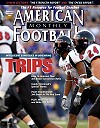AMERICAN FOOTBALL MONTHLY THE #1 RESOURCE FOR FOOTBALL COACHES
Article CategoriesAFM Magazine
|
The Scouting Reportby: Walt Harris© More from this issue Having earned a reputation as one of the great innovators and teachers during his 36 years of coaching, Walt Harris became the head football coach at Stanford on December 13, 2004. A South San Franciso native, Harris came ‘home.’ Last fall, the Cardinal came within one win of its first bowl game since 2001, finishing with an overall 5-6 record. Approaching his 60th birthday, Harris has coached in 14 bowl games, including six as a head coach while tutoring 11 first round draft picks and 14 NFL quarterbacks. Among the signal-callers he has coached include Tony Eason, Jack Trudeau and Dave Wilson. Before coming to Palo Alto, Harris was the head coach at Pittsburgh compiling an overall 52-44 record from 1997-2004. We spoke with Coach Harris recently about Stanford and how he prepares for his next opponent… 1.What is your process in analyzing an opponents’ game tape? We divide the tape by down and distance, special situations, personnel, and formations… those four areas. We then study our opponents’ Red Zone tendencies and various short yardage situations. We feel the game is played by down and distance situations, areas of the field, and personnel groupings. 2. What do you look for in scouting an opponents’ offense? Again, we look at down and distance as well as what personnel they have on the field. Additionally, we’ll look at different combinations of formations. For example, how often will they have two wide receivers on the same side of the field. We look at the quality of their people – are we facing a Reggie Bush type player this coming week. We then look at match-ups and what are best chances are for success. 3. What about scouting the opposing QB? Do you look for something specific? We look at little things to see if the quarterback tips off when he’s going to throw the ball. We also look at his decision-making, how is he as a scrambler, does he take a hit well and how he reacts to various kinds of pressure. Is he the kind of quarterback that makes things happen? 4. In scouting your opponent, how much of an emphasis is placed on situational tendencies? Quite a bit…We take into account down and distance, score, time remaining, personnel in the game at that time, and following game plan execution. 5.What are the keys you look for in scouting an opponents’ defense? The most important thing is match-ups. We may attack one player but stay away from another or potentially double team an All-American. We look for those players that have great pursuit and/or are great pass rushers and then game plan from there. In match-ups, we always want to give our players the best chance to be successful. 6. How much attention do you place in zone vs. man-to-man coverage? There are really three ways your opponent can defend you: fire zones, blitz zones, and man-to-man coverage. We face all three during the course of a game and all can involve bump and run and various pressure situations. We try to determine the percentages of each one and how they affect the quarterback. 7. Tell us your process of self-scouting? How important is it? It’s very important… it’s important to look at your own tendencies to see what you’re doing and repeating… there’s a fine line between doing the same things and adjusting your tendencies. From my NFL days I’ve learned you have to keep changing as it relates to down and distance. 8. How do you critique players after the self-scouting evaluation of their performance? We critique our players quite a bit during the off-season and during bye weeks…we continue to keep watching tape to see if our players are getting it done. Oftentimes they are aware of their competition and may slack off because they’re not being pushed. We’re constantly reminding them of improvement needed as the season goes on. 9. What’s a typical week like in breaking down film, giving it to the coaches, and preparing a game plan? Sunday: in the morning we analyze the game tape as a staff and I work with all three areas with special emphasis on offense. Monday: We break the game tape down and concentrate on down and distance situations. Tuesday: We familiarize our players with third down plays as well as second and long situations. Wednesday: We analyze Red Zone and short yardage situations. Thursday: We’d go through the game plan as a dress rehearsal as well as emphasizing both goal line situations and two minute drills. Friday: We have a walk-through and go through our first 15 plays. 10. Tell us about the digital system you use? This is our first season using DSV and we’re the first BCS team to use them. They’ve been tremendous in giving us the attention and service needed for year one. They’ve given us what we need and we appreciate the service they have given us. We plan to work with them in building their system in this ever-evolving business. p |
|
| HOME |
MAGAZINE |
SUBSCRIBE | ONLINE COLUMNISTS | COACHING VIDEOS |
Copyright 2024, AmericanFootballMonthly.com
All Rights Reserved




